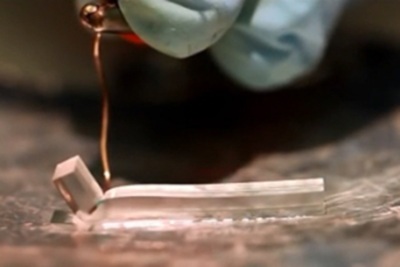Researchers have achieved a tremendous breakthrough in the field of soft robotics, creating a bot using water-based hydrogen material, so as to allow it to be patterned, folded, and manipulated to objects.

“This work brings us one step closer to developing new soft robotics technologies that mimic biological systems and can work in aqueous environments,” says Dr. Michael Dickey, an assistant professor of chemical and biomolecular engineering at NC State and co-author of a paper describing the work.
“In the nearer term, the technique may have applications for drug delivery or tissue scaffolding and directing cell growth in three dimensions, for example,” says Dr. Orlin Velev, INVISTA Professor of Chemical and Biomolecular Engineering at NC State, the second senior author of the paper.
The technique the researchers developed centers around the use of hydrogel, a water-based gel material composed of water and a small fraction of polymer molecules. The group found that they were able to modify and pattern sections of hydrogel electrically by using a copper electrode to inject positively charged sites on the polymer network in the hydrogel. When they did this, they linked the polymer molecules to each other and made the material stiffer and more resilient.

Water-based gel being exposed to copper.
In experimenting with the technique, the group further discovered that they could target specific areas with the electrodes to create a framework of stiffened material within the hydrogel.
What’s more, any pattern of ions they created has proven to remain stable for months in water.
“The bonds between the biopolymer molecules and the copper ions also pull the molecular strands closer together, causing the hydrogel to bend or flex,” Velev says. “And the more copper ions we inject into the hydrogel by flowing current through the electrodes, the further it bends.”
During the course of their research, the group found that they were able to use the increased stiffness and bending abilities of the material to manipulate objects. In one instance, they were able to create a V-shaped segment of hydrogel that closed in on an object as if it were a pair of soft tweezers.
When ions were injected into the back side of the hydrogel, the V opened, releasing the objects.
“We are currently planning to use this technique to develop motile, biologically compatible microdevices,” Velev said.
“It's also worth noting that this technique works with ions other than copper, such as calcium, which are biologically relevant,” Dickey added.
Video of the technology in action below:
The group’s paper, “Reversible patterning and actuation of hydrogels by electrically assisted ionoprinting,” is published online in Nature Communications .
Story via: eurekamagazine.co.uk
Advertisement
Learn more about Electronic Products Magazine





